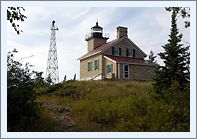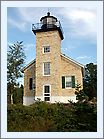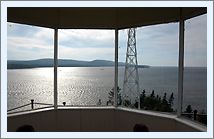|
Historical Information

With the discovery of copper in the Keweenaw, immigrant Cornish and
Finnish miners began flocking to the area to seek their fortunes and in
the words of one pioneer "the shores of the Keweenaw became
whitened with tents." Copper Harbor's natural harbor quickly
assumed significance as a supply point for the miners, and with the
influx of mining traffic the Federal Government established a Mineral
Land Agency office in the harbor to better regulate the growing mining
industry.
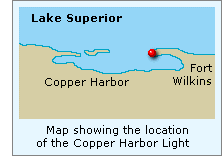 While Copper Harbor was both expansive
and well protected, vessels entering the harbor were forced to find
their way through a relatively narrow rocky opening. While great caution
had to be exercised during optimum conditions, finding the natural
harbor opening at night or during thick weather was a virtual
impossibility. The maritime community began raising its voice to
complain of the situation at Copper Harbor, and under the recommendation
of Stephen Pleasonton who was responsible for the nation's lighthouses
at the time, and on March 3, 1847 Congress appropriated $5,000 for the
construction of a light at the harbor entrance. While Copper Harbor was both expansive
and well protected, vessels entering the harbor were forced to find
their way through a relatively narrow rocky opening. While great caution
had to be exercised during optimum conditions, finding the natural
harbor opening at night or during thick weather was a virtual
impossibility. The maritime community began raising its voice to
complain of the situation at Copper Harbor, and under the recommendation
of Stephen Pleasonton who was responsible for the nation's lighthouses
at the time, and on March 3, 1847 Congress appropriated $5,000 for the
construction of a light at the harbor entrance.
The new station was erected on the
rocky point to the east of the harbor opening by contractor Charles
Rude, and consisted of a 48-foot tall rubble stone tower, which tapered
from thirty feet in diameter at the base to 20 feet in diameter at the
uppermost level. Capped with an octagonal lantern with a domed copper
roof similar to that which can still be seen at Rock Harbor, a
chandelier supporting an array of 13 Argand lamps with reflectors was
erected within. By virtue of the tower's construction atop the elevated
central ridge of the rocky peninsula, the lights sat at a focal plane of
65 feet. However, as a result of their inefficiency of the Argand lamps,
the new Copper Harbor light was only visible for a distance of four
miles in clear weather conditions.
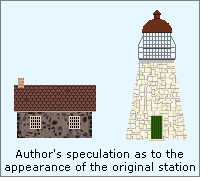 A 1½-story rubble stone dwelling was
located on the harbor side of the rocky point close to the water's edge.
The diminutive dwelling featured two rooms and a hallway on the first
floor, two bedrooms on the second floor, and a small kitchen in a
lean-to at the rear. While land access to the lighthouse was available
around the eastern end of the harbor, water access to the growing
village was faster, and a timber dock for the keepers boat was erected
at the water's edge near the dwelling. Construction of the station was
completed in 1848, however with the station's first keeper yet to be
appointed, Charles Rude was forced to leave a watchman to tend the
station until through the end of the navigation season. Henry Clow was
finally appointed to the position of keeper of the Copper Harbor Light,
and he arrived at the station on February 34, 1849, and took residence
in the new dwelling along with his wife and two children. A 1½-story rubble stone dwelling was
located on the harbor side of the rocky point close to the water's edge.
The diminutive dwelling featured two rooms and a hallway on the first
floor, two bedrooms on the second floor, and a small kitchen in a
lean-to at the rear. While land access to the lighthouse was available
around the eastern end of the harbor, water access to the growing
village was faster, and a timber dock for the keepers boat was erected
at the water's edge near the dwelling. Construction of the station was
completed in 1848, however with the station's first keeper yet to be
appointed, Charles Rude was forced to leave a watchman to tend the
station until through the end of the navigation season. Henry Clow was
finally appointed to the position of keeper of the Copper Harbor Light,
and he arrived at the station on February 34, 1849, and took residence
in the new dwelling along with his wife and two children.
By the early 1850's a cry arose in the
maritime community, voicing concern over Pleasonton's tight-fisted
administration of the nation's aids to navigation. A clerical
administrator, Pleasonton had no maritime experience, and it showed-up
in the sub standard workmanship and poorly chosen locations of many of
the lighthouses erected under his administration. A study commissioned
by Congress recommended the establishment of a nine-member Board to
oversee the administration of aids to navigation. Staffed with Navy
officers and Engineers from the Army Corps of Engineers, the Lighthouse
Board was established in 1852, relieving Pleasonton from any further
involvement. One of the Board's first orders of priority was the
upgrading of illumination systems from the dim and poorly performing
Argand lamps to the far more efficient and powerful Fresnel lenses
manufactured in Paris. However, with the Copper Harbor Light not being
of major importance in the greater scheme of things, it would be some
time before its lens would be upgraded, and thus the Argand lamps
continued to light the way into the harbor.
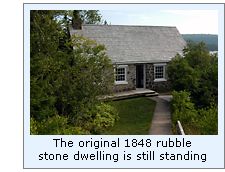 The lighthouse keeper's life was
evidently not to Clow's liking, as he resigned from his position on
August 5 1853, to be replaced by Henry C Shurter. Evidently Shurter was
not much better suited to the keeper's life, as he was removed from the
position and replaced by Napoleon Beedon on March 32, 1855. The lighthouse keeper's life was
evidently not to Clow's liking, as he resigned from his position on
August 5 1853, to be replaced by Henry C Shurter. Evidently Shurter was
not much better suited to the keeper's life, as he was removed from the
position and replaced by Napoleon Beedon on March 32, 1855.
In 1856, a work crew finally arrived in
at the station and removed the Argand lamps from the lantern, and
replaced them with a single fixed white Sixth Order Fresnel lens, thus
increasing the station's range of visibility to ten miles at sea. Three
years later, the Light was upgraded further through the replacement of
the Sixth Order lens with a more powerful fixed white lens of the Fourth
Order.
As was the case with virtually all of
the lighthouses built on the Great Lakes during the Pleasonton
administration, the true costs of inferior materials and shoddy
workmanship began to show. After his 1864 visit to the station, the
Eleventh District Inspector remarked that the Copper Harbor lighthouse
required "extensive repairs." On subsequent investigation, the
condition of the tower was determined to be beyond repair, and the
following year the decision was made to raze the old tower and erect a
completely new structure. With old Pleasonton-era stations needing
replacement at both Marquette and Ontonagon, and new stations planned
for Gull Rock, Huron and Granite Islands, the decision was made to build
all six lights to the same plan. Specifying a simple brick two-story
dwelling with a tower integrated into the center of one of the gable end
walls, this design would eventually become known as the
"schoolhouse" style, as a result of its similarity to the
design of rural nineteenth century one room schoolhouses.
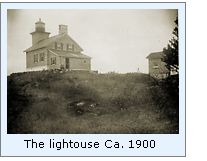 The lighthouse tender HAZE returned to
Copper Harbor in early 1866 and deposited a working crew and materials
on lighthouse point to begin construction of the new main lighthouse.
Work began with the demolishing of the old rubble stone tower, and
excavating the foundation for the new structure. Under normal
circumstances one would assume that the old tower would have been left
standing until the new station was complete. However, an archeological
survey conducted by the Michigan Technological University in 1994 showed
that a large portion of the stone from the old tower was reused in
building the foundation of the new building. Thus it is evident that the
old tower must have been demolished first. What steps were put in place
to allow the continued display of a light at the station for the time
period between the demolishing of the old tower and the completion of
the new structure are unrecorded. However, it is almost certain that
some arrangement for the display of a temporary light would have been
made. The lighthouse tender HAZE returned to
Copper Harbor in early 1866 and deposited a working crew and materials
on lighthouse point to begin construction of the new main lighthouse.
Work began with the demolishing of the old rubble stone tower, and
excavating the foundation for the new structure. Under normal
circumstances one would assume that the old tower would have been left
standing until the new station was complete. However, an archeological
survey conducted by the Michigan Technological University in 1994 showed
that a large portion of the stone from the old tower was reused in
building the foundation of the new building. Thus it is evident that the
old tower must have been demolished first. What steps were put in place
to allow the continued display of a light at the station for the time
period between the demolishing of the old tower and the completion of
the new structure are unrecorded. However, it is almost certain that
some arrangement for the display of a temporary light would have been
made.
Atop the rubble stone foundation, a
team of masons erected a Cream City brick building, and its 42-foot tall
tower capped with a square gallery with iron safety railing. A spiral
cast iron stairway within the tower provided the only means of passing
between the first and second floors in addition to providing access to
the lantern. Centered atop the gallery, a decagonal prefabricated cast
iron lantern was installed, and the Fourth Order lens from the old tower
reassembled atop a cast iron pedestal at the center of the new lantern.
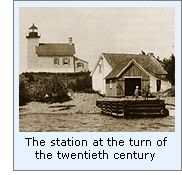 Two years later in 1868, the Eleventh
District Inspector reported that he found everything at the station to
be in "good condition," with the exception of the water
cistern, which was found to be leaking, which was repaired the following
year. However, 1869 is more memorable as the year in which Napoleon
Beedon resigned from lighthouse service after fourteen years as keeper
of the Copper Harbor Light. John Power was selected to replace Beedon,
arriving to take over the Light on September 1. As yet, we have been
unable to determine the reason behind Napoleon Beedon's resignation.
However, it is interesting to note that after fourteen years at Copper
Harbor, lighthouse keeping was evidently in Beedon blood, as he would
subsequently reenter lighthouse service and serve as keeper at Grand
Island Harbor and at Au Sable Point before resigning a second time in
1879. Two years later in 1868, the Eleventh
District Inspector reported that he found everything at the station to
be in "good condition," with the exception of the water
cistern, which was found to be leaking, which was repaired the following
year. However, 1869 is more memorable as the year in which Napoleon
Beedon resigned from lighthouse service after fourteen years as keeper
of the Copper Harbor Light. John Power was selected to replace Beedon,
arriving to take over the Light on September 1. As yet, we have been
unable to determine the reason behind Napoleon Beedon's resignation.
However, it is interesting to note that after fourteen years at Copper
Harbor, lighthouse keeping was evidently in Beedon blood, as he would
subsequently reenter lighthouse service and serve as keeper at Grand
Island Harbor and at Au Sable Point before resigning a second time in
1879.
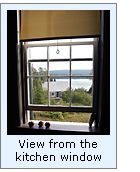 By the 1880's, the mines in the eastern
tip of the Keweenaw had all but closed, and with opening of the Portage
Lake Ship Canal, many vessels were using the short cut it represented.
Thus, the volume of maritime traffic both entering and passing Copper
Harbor diminished. Ever watchful for an opportunity to reduce costs, the
Lighthouse Board determined that two lights in the harbor were overkill.
Since the range lights could be seen from outside the harbor, the Board
decided that they could perform double duty as both range and as a coast
lights, and decided to shut down the main light and eliminate the cost
of operating the light. Thus, in 1884 the main light was extinguished,
and the keeper of the Range Lights put in charge of the building and
grounds. By the 1880's, the mines in the eastern
tip of the Keweenaw had all but closed, and with opening of the Portage
Lake Ship Canal, many vessels were using the short cut it represented.
Thus, the volume of maritime traffic both entering and passing Copper
Harbor diminished. Ever watchful for an opportunity to reduce costs, the
Lighthouse Board determined that two lights in the harbor were overkill.
Since the range lights could be seen from outside the harbor, the Board
decided that they could perform double duty as both range and as a coast
lights, and decided to shut down the main light and eliminate the cost
of operating the light. Thus, in 1884 the main light was extinguished,
and the keeper of the Range Lights put in charge of the building and
grounds.
Maritime interests quickly raised their
voices to make the Board aware of the folly of the decision to close the
Copper Harbor Light. Located deep within Copper Harbor as they were, the
range lights were invisible until vessels were in front of the harbor
entrance. After passing the Manitou and Gull Rock Lights, up-bound
mariners now found themselves coasting blind along the treacherous
Keweenaw shoreline until they were able to pick up the Eagle Harbor
Light. After a number of protests were registered, the Lighthouse Board
realized the errors of the decision, and ordered the reactivation of the
Copper Harbor main light on February 17, 1888. A work crew arrived to
prepare the station for reactivation that May, and with the arrival of
Mr. Crump, the District Lampist, on May 22, work began on the
installation of a new Fourth Order lens in the empty lantern.
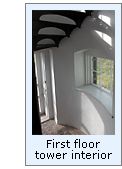 Henry Corgan, who had lived for some
time at the Copper Harbor Light while his father Charles was Keeper from
1873 through 1881, had followed in his father's footsteps, entering
lighthouse service in 1868 as First Assistant at Manitou. While later
serving as keeper at Point Peninsula, Corgan learned of the Board's
plans to reactivate the Copper Harbor Light, and evidently having fond
memories of the place, managed to convince District Inspector Commander
Horace Elmer to reassign him as keeper at his father's old station. Henry Corgan, who had lived for some
time at the Copper Harbor Light while his father Charles was Keeper from
1873 through 1881, had followed in his father's footsteps, entering
lighthouse service in 1868 as First Assistant at Manitou. While later
serving as keeper at Point Peninsula, Corgan learned of the Board's
plans to reactivate the Copper Harbor Light, and evidently having fond
memories of the place, managed to convince District Inspector Commander
Horace Elmer to reassign him as keeper at his father's old station.
With the renovation work close to
completion, the light was reactivated on the night of June 1, 1888, and
was tended by the work crew for five days until Henry Corgan arrived to
take over the station on June 6.
Things were relatively uneventful at
Copper Harbor over the next thirty years, with Corgan serving as the
single keeper throughout the entire period. Little mention of the
station is made in official government documents until 1893, when it was
mentioned that Corgan built a small boathouse and a work crew arrived to
lay 200 feet of sidewalk connecting the new boathouse to the lighthouse.
Two years later, a new boat landing was erected, and a barbed-wire fence
installed across the point to keep visitors off the property. 1907 saw
the arrival of a crew to upgrade Corgan's diminutive boathouse with a
more substantial structure and to erect a new stone-filled timber boat
landing.
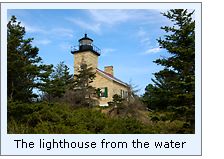 After the abolishment of the Lighthouse
Board in 1909, and the transfer of responsibility for the nation's to
the newly formed Lighthouse Service under the direction of George
Putnam, major strides were taken to incorporate new technology
throughout the system. With recent advances in acetylene lighting
technology, and the reliable sun valve which could be used to
automatically illuminate and extinguish the light at dusk and dawn, a
move was on to automate a number of the nation's lighthouses, thereby
eliminating the cost of keepers at the stations. To this end, an
acetylene illumination system was installed within the Copper Harbor
Fourth Order Fresnel lens on June 23, 1919, and the light's
characteristic simultaneously changed to a white flash of 0.3-second
duration followed by a 2.7-second eclipse. Emitting 750 candlepower, the
new light was now visible from a distance of 15 miles at sea. No longer
needed to tend the light, the 66-year old Corgan accepted a transfer to
the St. Clair Flats South Ship Canal Light, leaving Copper Harbor for
good. After the abolishment of the Lighthouse
Board in 1909, and the transfer of responsibility for the nation's to
the newly formed Lighthouse Service under the direction of George
Putnam, major strides were taken to incorporate new technology
throughout the system. With recent advances in acetylene lighting
technology, and the reliable sun valve which could be used to
automatically illuminate and extinguish the light at dusk and dawn, a
move was on to automate a number of the nation's lighthouses, thereby
eliminating the cost of keepers at the stations. To this end, an
acetylene illumination system was installed within the Copper Harbor
Fourth Order Fresnel lens on June 23, 1919, and the light's
characteristic simultaneously changed to a white flash of 0.3-second
duration followed by a 2.7-second eclipse. Emitting 750 candlepower, the
new light was now visible from a distance of 15 miles at sea. No longer
needed to tend the light, the 66-year old Corgan accepted a transfer to
the St. Clair Flats South Ship Canal Light, leaving Copper Harbor for
good.
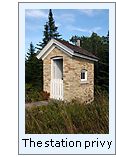 Only needing access to the tower to
service the lens and acetylene system, the Lighthouse Service began
leasing the lighthouse dwelling to private individuals as a summer
cottage in 1927. With the tower stairs serving double duty as the only
access to the second floor of the dwelling and to the lantern, it was
difficult to maintain privacy for the tenants when crews arrived at the
station to maintain the light. Thus, in 1933, the decision was made to
erect a 62-foot high steel skeleton tower close to the site of the
original 1848 tower. The Fresnel lens in the old lantern was a delicate
assembly, and not intended to be installed in a location where it would
be directly exposed to the elements. The Fourth Order lens was thus
disassembled and shipped to the Detroit depot for storage, and the new
steel tower capped with a 300-mm lens, which was plumbed into the
acetylene system, which had been relocated from the old tower. Only needing access to the tower to
service the lens and acetylene system, the Lighthouse Service began
leasing the lighthouse dwelling to private individuals as a summer
cottage in 1927. With the tower stairs serving double duty as the only
access to the second floor of the dwelling and to the lantern, it was
difficult to maintain privacy for the tenants when crews arrived at the
station to maintain the light. Thus, in 1933, the decision was made to
erect a 62-foot high steel skeleton tower close to the site of the
original 1848 tower. The Fresnel lens in the old lantern was a delicate
assembly, and not intended to be installed in a location where it would
be directly exposed to the elements. The Fourth Order lens was thus
disassembled and shipped to the Detroit depot for storage, and the new
steel tower capped with a 300-mm lens, which was plumbed into the
acetylene system, which had been relocated from the old tower.
The Coast Guard, which had assumed
responsibility for the nation's aids to navigation in 1939, decided that
it no longer wished to serve as landlord at Copper Harbor, and placed
the building and reservation up for sale in 1957. The State of Michigan
purchased the buildings for $5,000, and incorporated them into the Fort
Wilkins State Park. Restoration efforts began in the early 1970's, and
the buildings were eventually opened-up as a museum in 1975. The main
lighthouse has been restored to reflect its appearance at the turn of
the twentieth century, and the original keepers dwelling has been
converted into a museum, with exhibits showing aspects of daily life at
the station.
Keepers of this
Light

Click here
to see a complete listing of all Copper Harbor Light keepers compiled by
Phyllis L. Tag of Great Lakes Lighthouse Research.

Seeing this Light

Take US41 into Copper Harbor, and continue North through the village.
You will find Fort Wilkins State Park on the right, and a parking area
on the left. Park your vehicle in the parking area and walk to the
lakeshore. The lighthouse can be seen across the bay.
For the best view of
the light station, the Copper Harbor Lighthouse Ferry Service is the
only way to go. Their boat leaves the municipal dock three times a day
for an enjoyable 15-minute cruise across Copper Harbor, and ties up at
the same dock used by the keepers many years ago.
After arriving at the
dock, you join a Michigan Department of History staff member who
provides an informative and comprehensive tour of the entire light
station complex.
For more information on
tour schedules and fees, click here
to visit the Copper Harbor Lighthouse website, or telephone (906)
289-4966 for information.

Contact information

Fort Wilkins State Park
East US-41
Copper Harbor, MI 49918
(906) 289-4215

Reference Sources

Annual reports of the Fifth Auditor of the
Treasury 1848 & 1849
Annual reports of the Lighthouse Board. Various - 1856 through
1907
Annual report of the Lake Carriers Association, Various - 1919
through 1937
Great Lakes Light Lists – Various - 1849 through 2004
1858 & 1910 surveys of the Copper Harbor Lighthouse. USCG CD
database
History & Archaeology of the First Copper Harbor Lighthouse.
Barry James & Grant Day. 1995.
Copper Harbor Light Station, Mich. Plan showing location of
original drawings. NARA RHL 704-679
History of the Great Lakes. Volume I . J. B. Mansfield. 1889
Adventures in the wilds of the United States and British American
provinces." Charles Lanman. 1856.
The metallic wealth of the United States" Josiah Dwight Whitney. Pub.
1856.
Lake Superior. Grace Lee Nute. 1944
Copper Harbor lighthouse – Michigan Department of Arts, Histories
and Libraries website
Information contained on interpretive displays at the Copper Harbor
lighthouse itself.
Keeper listings for this light appear
courtesy of Great
Lakes Lighthouse Research
|
